Servicios Personalizados
Revista
Articulo
Indicadores
-
 Citado por SciELO
Citado por SciELO -
 Accesos
Accesos
Links relacionados
-
 Similares en
SciELO
Similares en
SciELO
Compartir
Revista Latinoamericana de Desarrollo Económico
versión impresa ISSN 2074-4706versión On-line ISSN 2309-9038
rlde n.5 supl.1 La Paz jul. 2005
Macroeconomic Policies to Increase Social Mobility and Growth in Bolivia*
Alejandro F. Mercado**, Lykke E. Andersen, Alice J. Brooks
Abstract
Poverty in Bolivia continues to be among the highest in Latin America despite decades of concerted national and international efforts to reduce it. The external aid has been generous and foreign direct investment has boomed; nevertheless, average productivity and incomes remain at the same low level as they were 50 years ago.
This paper suggests that the failure of previous development policies is due to a lack of social mobility in the country. Without social mobility, there is little incentive for people to invest in human and physical capital, and without investment there cannot be productivity growth. In addition, the lack of social mobility implies an inefficient use of human capital, and it hinders the construction of efficient social mechanisms for redistribution and consumption smoothing over the life-cycle.
Resumen
La pobreza en Bolivia es una de las más altas de Latinoamérica y, a pesar de los grandes esfuerzos nacionales, así como de la generosa cooperación externa, la situación no ha cambiado substancialmente en los últimos cincuenta años.
Esta investigación sugiere que los fracasos de las políticas para reducir la pobreza se deben a una muy baja movilidad social que caracteriza a la economía y la sociedad bolivianas. Una reducida movilidad social implica la inexistencia de incentivos para que la gente invierta en capital humano. Sin incrementos en la inversión en capital humano, el crecimiento que se puede lograr será muy reducido.
1. Introduction
Poverty in Bolivia has become an endemic phenomenon. We were poor yesterday, we are poor today and, most likely, we will be poor tomorrow. Bolivia has experimented with almost all conceivable economic policies. We have nationalized, denationalized, privatized, capitalized and nationalized again, while we continue to be stuck in poverty. We have applied Keynesian programs to overcome economic crises and the results obtained were tremendously negative. Increased public expenditures only resulted in larger fiscal deficits, devaluations did not have a perceptible effect on our balance of payments (on the contrary, they only further restricted the productive apparatus by raising the prices of imported capital goods), and an expansive monetary policy only resulted in a reduction of net international reserves and a reduction in the purchasing power of the local currency due to inflationary pressures.
Foreign aid to Bolivia has been extremely generous, in some years surpassing 10 per cent of GDP. The same holds for Foreign Direct Investment (FDI) which has been attracted by Bolivia's large reserves of natural gas and petroleum and by the privatization and liberalization of telephony, electricity, and several other important service sectors (Nina y te Velde, 2003). While these large, targeted inflows of dollars have clearly contributed to improving access to basic services such as education, health, water, sanitation, electricity and telecommunication, the income earning capacity of the Bolivian people remains at the same level as it was 50 years ago (Andersen y Evia, 2003).
Due to a concerted poverty reduction strategy, heavily supported by the international development community, public expenditures in the social sectors have increased from around 6 percent of GDP in the early 1980s to 16 percent by 2001 Nevertheless, the resulting reduction in poverty has been frustratingly small (Mercado et al., 2003).
This paper will argue that the failure of the poverty reduction strategies in Bolivia arises from treating poverty as a static problem, while in reality it is a highly dynamic problem. A fifty percent poverty rate can mean two very different things. One interpretation might be that the whole population is poor half of the time; alternatively, one might conclude that 50 percent of the population is always poor, while the remainder is unlikely to become trapped in poverty. The first is a much easier kind of poverty to deal with both at the private level and at a public policy level, since poverty is transitory for each household, at least in intergenerational terms. This kind of poverty can be relieved through unemployment benefits, pension savings, borrowing, and a large set of other types of transfers aimed at smoothing consumption over the life cycle.
On the other hand, if it is the same families who are poor all the time, it is much more difficult to develop strategies to alleviate the hardship. Poor people cannot save for harder times, as all times are hard times, and they cannot borrow against higher future income because they don't expect their incomes to be any better in the future. From a social point of view, it is difficult to devise transfer mechanisms, as the transfers would always be one-way and unless the mechanism is capable of lifting the beneficiary out of poverty on a permanent basis, would need to be sustained for a lengthy period during the beneficiary's lifetime. Few people are willing to pay high taxes if they don't expect to receive any benefits from those taxes themselves, and the perverse incentives generated by non-transitory social welfare programs further limit their usefulness.
While a tremendous amount of attention has been paid to poverty and inequality during the last decade, very little attention has centered on the dynamics of poverty and inequality, which we will call social mobility. If social mobility is high, people move around in the income distribution from year to year and from generation to generation depending partly on their own efforts (how much they study, how hard they work, how much they save, how they invest) and partly on external factors (health, luck, changing family composition, macroeconomic conditions, etc.).
If social mobility is low, on the other hand, people are stuck at a specific place on the income distribution scale year after year and generation after generation - only an enormous amount of effort or luck can change this situation. This is not only unfair and difficult to alleviate through redistribution, it also tends to reduce the amount of effort and investment in the country, as there is no link between effort and result. Poor people are unlikely to make the sacrifices involved in studying many years, working hard, saving, and investing, if they don't expect that effort pay off in the future. This creates a vicious circle as the expectation that effort will not return benefits will in turn prevent them from making an effort. This self-fulfilling prophesy leads to people not making an effort that could possibly improve their situation.
The few empirical studies on social mobility that have recently surfaced unanimously agree that Bolivia has very low social mobility (Behrman, Birdsall and Szekely, 1998; Dahan and Gaviria, 2000; Andersen, 2001a). This implies that poverty is permanent and extremely difficult to either reduce or alleviate. In addition, low social mobility reduces incentives for growth, and since low growth reinforces low social mobility, the country is stuck in a vicious circle. Faced with this new dynamic view of Bolivia's problems, the present paper discusses what has gone wrong with previous policies, and what can be done in the future to increase social mobility and thus leave the vicious circle of low social mobility, low growth, and permanent poverty.
The paper is divided into five sections. This first section serves as an introductory overview of the work. The second section presents a revision of the theoretical and empirical work on the relationship between social mobility and development. The third section presents a short diagnosis of the macroeconomic situation that has characterized our economy over the past two decades, discussing what has been done to reduce poverty and the results obtained to date. Section four investigates the sources of the lack of social mobility in Bolivia and discusses what can be done to improve the situation. Section five provides some concluding remarks and suggests areas of future research.
2. Social Mobility and Development
2.1. Review of the Theoretical Literature
The theoretical literature on development is vast, but the ones taking into account social mobility are very few. They all arrive at the conclusion that high social mobility is associated with higher economic growth, but the transmission mechanisms between mobility and growth differ between the models.
Raut (1996) develops an endogenous growth model where the growth rate depends on the quantity and quality of technological and scientific research. In turn, the level of research depends on the talents and educational level of the researchers. Only researchers with particular talents and a minimum necessary level of education can perform research that furthers economic growth. People with an excellent education but without sufficient talent cannot contribute to economic growth. The same thing happens with very talented people lacking the necessary education. The conclusion of this model is that growth is maximized when people receive an education that corresponds to their talent. The model supposes that talents are randomly distributed among the population and that the individual level of talents is private information. Employers cannot observe the level of the employees' innate talents, which creates asymmetric information important for the functioning of the model.
Education improves the productivity of employees and it also provides clues to their individual talent levels. Raut's model presumes that achieving a certain level of education is more expensive for people with lesser talent in comparison to those with more talent. Also, to introduce intergenerational relationships, the model supposes that obtaining education is less expensive for children of educated parents.
Each person chooses his or her education level by taking costs and benefits into account. The benefits are the wages that employers offer. Employers will offer higher wages for better educated people, not only because they should be more productive, but also because they should have more innate talent. The difference in wages for people with less education and people with more education depends on employers' expectations regarding the relationship between innate talents and education. If employers believe that education is a good indicator of innate talents, they will conclude that educated people are more productive. Employers' can thus offer them higher wages. On the other hand, if employers' believe that education is not a good indicator of innate talents, people with more education are not necessarily deemed more productive and thus will not be offered higher wages.
While offered wages are important for decisions on education, employers' expectations become very important for growth. If employers believe that education is a good indicator of innate talents (that the education level depends more on the innate talents than the level of parents' education), they will offer better returns to education.
As a consequence, employees will opt for more education, which will make them more productive. With more productive workers the economic growth rate will be higher.
The model generates a variety of possible equilibriums. One kind of equilibrium (pooling equilibrium) is that all employees choose the same education level and, therefore, all will receive the same wage. We can call this equality, but it does not produce the maximum level of possible growth. In this scenario education does not provide clues to employers about employee talent levels and productivity. As a result, employers will offer lower wages and the workers will also choose lower education levels.
There is a second equilibrium (separating equilibrium), where the workers will choose different education levels depending on their talents and the education of their parents. At the extreme of this second equilibrium, the education of the parents determines the education of their children. We can call this zero social mobility. This equilibrium does not generate an optimum growth level, for the reasons previously stated. A third possible equilibrium consists of all employees who have the same innate talents choosing the same education level, independent of their family background. This can be called equilibrium with equality of opportunities. Raut shows that in this case the rate of growth is higher than in the previous cases. He also shows that the case with maximum growth belongs to the group with equality of opportunities.
To move an economy from a low social mobility-low growth equilibrium to a high mobility-high growth equilibrium will require a change in the employers' self-fulfilling expectations about the importance of family background compared to the importance of innate talents. One way of achieving this change could be a government policy targeted at making the optimal education available for all children independent of their family background. This, in turn, requires a wide range of policy initiatives, ranging from pre-natal care to college loans.
Galor and Tsiddon (1997) also explore the links between technological progress, wage inequality, social mobility and growth, and develop a model that creates cyclical patterns in all four variables. The model assumes that there are two factors that determine earnings: the individual's innate ability and parental human capital. In periods of major inventions, innate ability becomes relatively more important, while the relative importance of family background diminishes. This means higher social mobility, but also higher wage inequality because of a higher concentration of high-ability, better-educated individuals in technologically advanced sectors. This concentration of human capital in technologically advanced sectors would stimulate further inventions and future output growth. In subsequent periods, when the new technologies become more accessible to the rest of society, parental human capital will become relatively more important again, thus decreasing earnings mobility and decreasing inequality while making the latter more persistent. The model has the unlikely implication that user friendliness - placing technological advances within the reach of most members of society - is bad for growth.
The analysis suggests that earnings mobility governs the pace of technological progress and output growth, while technological progress determines the degree of wage inequality and intergenerational earnings mobility. One of the conclusions of the paper is that social impediments to earnings mobility may distort the allocation of talent across occupations, thus reducing the pace of new inventions and output growth.
The links between growth and social mobility are also explored in a study by Hassler and Rodriguez Mora (2000). The model includes two types of individuals: workers and entrepreneurs. Entrepreneurs are the ones that generate new ideas and new technologies and make the economy grow. The more intelligent the entrepreneurs the higher the growth rate of the economy. Intelligence is randomly distributed among all people. With low social mobility the current generation of entrepreneurs mainly consists of the children of the previous generation of entrepreneurs. From an intellectual point of view, they are a random sample of society's entire population, and consequently, they have average levels of intelligence. The entrepreneurs are therefore not particularly innovative, and they do not change the world substantially. The entrepreneurs do, however, confront economic challenges, and they learn from these and pass this knowledge on to their children. This is sufficient to give the children of entrepreneurs the slight advantage that will make them the entrepreneurs of the next generation. Consequently, the intelligence of entrepreneurs in an economy with low social mobility will remain at an average level, and the economy will grow only moderately.
In an economy with high social mobility, on the other hand, the entrepreneurial class is formed by the most intelligent people irrespective of their family background. Since the entrepreneurs are very intelligent they can generate a great deal of technological change and rapid growth. They thus make the world change rapidly, and the experience that they can pass on to their children depreciates so quickly that it is of little or no value The next generation of entrepreneurs will thus be formed by intellectually gifted people rather than necessarily the children of entrepreneurs, since the children of entrepreneurs have no particular advantage in a rapidly changing world. This implies that the economy with high social mobility will enjoy consistently higher growth.
Several other papers show how the allocation of talent in an economy is important for the level of growth. Murphy, Shleifer, and Vishny (1991), for example, show that when talented people are attracted to the productive sector, they create high growth, but if they instead are attracted to rent seeking activities, they create stagnation. Their model has an interesting implication regarding discrimination in a country where rent seeking is the most lucrative sector (which could be the case in Bolivia1). If talented people are attracted to the rent seeking sector because it offers the highest returns, then discrimination may actually cause higher growth. This is the case if a dominant group monopolizes access to the rent seeking sector, because then the more intelligent people from the excluded population will have to work in the productive sector and thus some growth is generated.
In a related paper, Baumol (1990) argues that while it may be difficult for economic policy to affect the supply and quality of entrepreneurs, it may be possible to affect the allocation of entrepreneurship between productive and unproductive sectors, such as rent seeking and organized crime.
Hassler, Rodriguez Mora and Zeira (2002) develop a model where social mobility and wage inequality is determined simultaneously and endogenously. In this model they show that wage inequality has two opposing effects on upward social mobility: the incentive effect and the distance effect. When future wage inequality is expected to be high, this provides an incentive for investment in education, which increases upward mobility. However, high wage inequality also reduces the possibility for the poorest segments of the population to invest in education, thus decreasing their upward mobility. This second and opposing effect is called the distance effect. This undesirable effect can be partially counteracted by public investment in education, but the model also shows that educated parents are likely to be better at taking advantage of general public education, implying that public education expenditure may increase inequality of opportunity over time rather than decrease it.
The implication of the above mentioned studies is that to achieve optimum growth it is important that people get the education that correspond to their innate talents and then gain access to work in sectors where they are most productive. This requires that young people's educational and occupational choices be determined by talent and not limited by family background, or in other words, high growth requires a high degree of social mobility. In addition, it is important that there is a certain amount of wage inequality in the society in order to provide incentives for investment in education. On the other hand, inequality should not be too high, because that would prevent poor people from investing in education for their children.
High social mobility is not a sufficient condition for high growth. It also requires that productive activities yield higher returns to talent than unproductive rent seeking activities. If talent is attracted to rent seeking activities rather than productive activities, then growth will be limited irrespective of the degree of social mobility present in the society.
2.2. Review of the Empirical Literature
There have been three important attempts at estimating social mobility in Bolivia and comparing it with social mobility in other Latin American countries (Behrman, Birdsall and Szekely, 1998; Dahan and Gaviria, 2000; and Andersen, 2001a). All three studies use standard household surveys, since there are no panel data sets available that cover the same families in Bolivia over time.
The basic idea behind all three studies is to measure how important family background is in determining the educational outcomes of young people. If family background is important in determining young peoples' educational level (and through that future income levels) social mobility is considered low. If family background is unimportant, social mobility is high.
Behrman, Birdsall and Szekely (1998) and Andersen (2001a) measure the influence of family background directly in regressions with schooling gaps as the dependent variable and family background variables as explaining variables. Schooling gaps reflect missing years of education under the assumption that all children should start in school at age 6 (or in some countries 7) and advance one grade each year until they are 19 years old. Grade repetition and school drop out generates schooling gaps, which are presumed to be negatively correlated with future income earning capacity. Dahan and Gaviria (2000) measure the influence of family background indirectly by calculating the correlation of schooling gaps between siblings.
The advantage of the Dahan and Gaviria social mobility index is that it does not require the a priori definition of what family attributes are important (e.g. mother's education, family wealth, parental attitudes, etc.) Their index controls for all influences that are common to all children in the same family. The disadvantage is that at least two siblings in the relevant age range are needed for each family. This implies a dramatic reduction in the sample of young people. Worse, the ones that are left out are unlikely to be similar to those that are included in the analysis, since teenagers with many siblings are much more likely to be included.
Andersen (2001a) provides some refinements and improvements to the method proposed in Behrman, Birdsall and Szekely (1998). First, the method for determining the importance of family background (Fields' decomposition (see Fields, 1996)) is scale-independent, so results do not depend on, for example, the currency in which income is measured. This allows for easy comparison across countries and regions. Second, the method does not require a provision of weights for the different family background variables. Third, the method allows single parent households to be included in the analysis, because the maximum of mother's and father's years of education is used rather than both at the same time. Fourth, Andersen (2001a) provides confidence intervals for all social mobility estimates, so that the reader can see whether different measures are actually statistically different. Fifth, in the case of Bolivia, Andersen (2001a) provides national estimates, while Behrman, Birdsall and Szekely (1998) only include urban Bolivia.
Since Andersen (2001a) is the only study that reports confidence intervals on the social mobility estimates, the current paper uses these estimates. The index is defined as one minus the importance of family background, implying that higher values of the index are associated with higher social mobility. Family background is proxied by the maximum number of years of education of the mother and the father and average adult per capita income in the household, and the importance of these two variables is measured by the Fields' decomposition (see Fields, 1996). Figure 1 shows the social mobility estimates for 18 countries in Latin America.
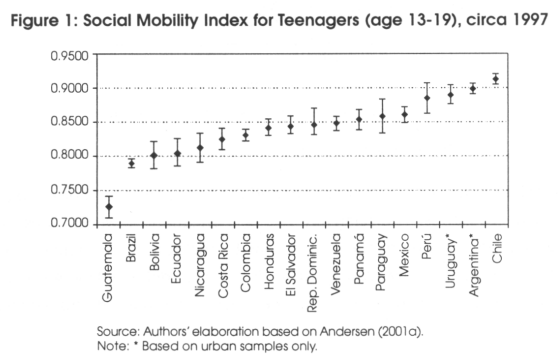
The Figure suggests that Bolivia is among the least socially mobile countries in Latin America together with Guatemala, Brazil, Ecuador, and Nicaragua. Chile, Argentina, Uruguay, and Peru, on the other hand, are among the most socially mobile countries in Latin America. The social mobility estimates for Uruguay and Argentina are based on urban samples only, but these two countries are so highly urbanized (> 80 per cent) that this is almost representative for the whole country.
The widths of the confidence intervals reflect the sample sizes used to estimate the index. The estimate for Brazil is based on 11.761 teenagers, which implies a relatively precise estimate. The estimate for Peru is based on only 2.800 teenagers, which implies a much wider confidence interval.
Andersen (2001a) finds a relatively strong positive correlation between Social Mobility and GDP per capita across 18 countries in Latin America, thus lending some empirical evidence to the theoretical arguments presented above.
Figure 2 suggests that Argentina2, Chile, and Uruguay are located in high growth -high social mobility equilibrium, while Guatemala, Bolivia, Nicaragua, and Colombia are stuck in low growth - low social mobility equilibrium (assuming that the higher per capita GDPs are caused by higher long term growth rates).
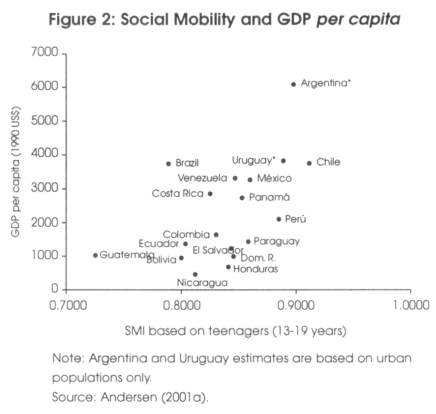
The correlation between GDP per capita and the Social Mobility Index is 0.53 across Latin American countries. The relatively strong correlation, however, does not imply anything about the direction of causality. It may be that low social mobility causes low growth, or it may be that low growth causes low social mobility. Low growth and low mobility may also be jointly determined as the theoretical models discussed above have explored.
Figure 3 shows that there is only a very weak or no correlation between social mobility and income inequality (p = -0.12). This corresponds to the theoretical review, which suggests that there is not necessarily any relationship between the two. Guatemala, Ecuador, Brazil, and Bolivia all have low social mobility and high income inequality. In these countries there is a large gap between rich and poor and there is little chance of crossing that gap. Chile, Paraguay, and Argentina also have high income gaps between rich and poor, but the chance of crossing the gap is substantially higher This implies that the incentive structure in these countries is much better.
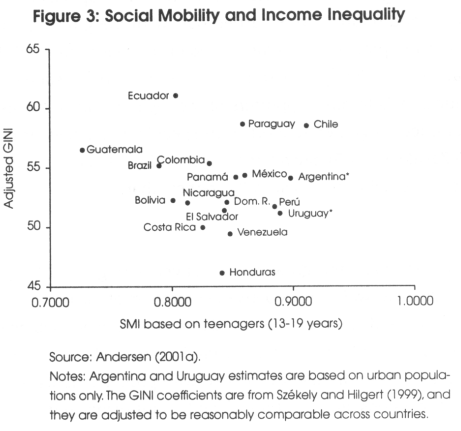
While low mobility and high income inequality is clearly the worst combination, high mobility and low income inequality is not necessarily the best. There has to be a certain amount of inequality to provide incentives for people to study hard, work hard, be innovative, and take risks.
3. Macroeconomic Context and Poverty Reduction Efforts
The low social mobility in Bolivia is to a large extent historically determined. Before the 1952 revolution, the Bolivian economy essentially relied on the production of tin, an industry composed of three major private firms -Patiño, Hochschild and Aramayo Trading Co.- which, by providing around 2/3 of the state's revenues, exerted extraordinary political and economic influence. At the same time, the agricultural system was based on large land holdings in the hands of a few, with an archaic quasi-feudal production structure with extremely low productivity (Kaufman, Mastruzzi and Zavaleta, 2003). Wealth was concentrated in relatively few families with enormous economic and political influence to secure that public policies were working in their interests.
The violent revolution in 1952 brought to power the National Revolutionary Movement (MNR) whose ideology consisted of overthrowing the mining-landlords oligarchy and creating a national state based on "state capitalism " The mines were nationalized and land reforms were carried out. With the growing role of the state in the operations of the productive sector, the political realities favored the development of an elaborate system of "job patronage", i.e. the use of state-owned-enterprises (SOEs) as political tools to hire supporters of the regime, and "clientilism" - the use of SOE public contracts to garner support from specific individuals or groups (Kaufman, Mastruzzi and Zavaleta, 2003). Such a system contributed to low social mobility, as jobs and contracts were allocated politically rather than on the basis of merit and productivity.
This system continued and grew even stronger during Hugo Banzer's dictatorship (1971-1978) as alliances were struck between members of the business community and the military regime, and trade unions and labor classes were subjected to repressive measures. Friends of the government, particularly in the military and among the private business community, were frequently favored with property rights over hitherto public lands, mining concessions, and most importantly, subsidized credit (Morales and Sachs, 1990).
Banzer's reign was a period of relatively high growth (see Figure 4) due to favorable commodity prices, a boom in the production of gas, and large influxes of capital financed through heavy borrowing. In 1982, when external commodity prices plummeted and external capital dried up, a series of military governments gave way to a democratically elected government. However, the new government failed to make the necessary macroeconomic adjustments and instead led the country into a hyperinflation peaking at 25,000 per cent annually in 1985 The crisis let to a dramatic reduction in output and drove a large number of firms into bankruptcy. However, during the same period, elite firms or individuals, with access to subsidized hard currency through special relations with the Central Bank could enrich themselves by reselling foreign currency in the black market at 15 times its subsidized cost (Kaufman, Mastruzzi and Zavaleta, 2003).
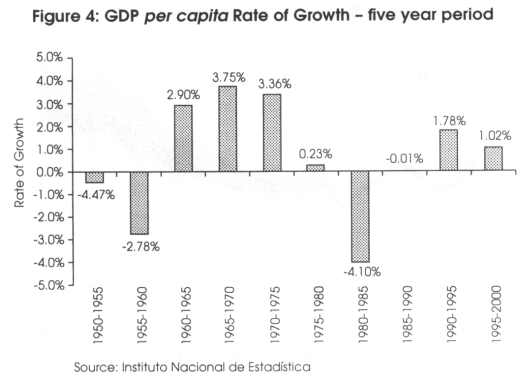
Thus, at least until 1985, Bolivia has been characterized by an extremely unlevel playing field, where public policy benefited the rich and influential, while the poor were adversely affected and had little chance of improving their situation.
This started to change in 1985 when three times ex-president Victor Paz Estenssoro introduced the New Economic Policy (NEP) (through Supreme Decree No. 21060) which has become the axis of economic policy from that point on. The plan included a very successful stabilization package and basic economic policies in line with the Washington Consensus. The plan was later complemented by structural and social reforms, with heavy support from the international development community.
The first generation of reforms took place during the period 1989 to 1993 when the fight against poverty became more explicit, largely due to the emphasis placed on the issue by the international community. The education reform was initiated during this period, and governmental budget support to social sectors began to increase as a percentage of total outlays (see Figure 5).
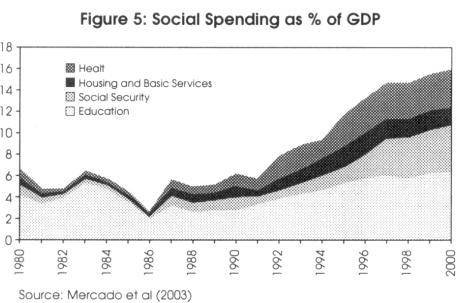
With the inclusion of Bolivia in 1997 in the HIPC program designed by the Bretton Woods institutions, a new focus was given to poverty reduction strategies. According to figures prepared by CEDLA, 2003, in the following table, public investment in social sectors has increased dramatically at the expense of investment in extractive activities and infrastructure.
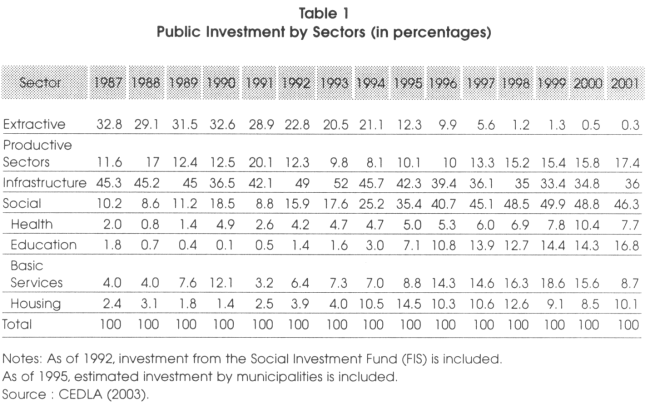
It was expected that such dramatic increases in social spending and investment would be beneficial for the poor, but although coverage rates of social services have indeed increased, and some substantially so, income poverty rates have remained stubbornly high, especially in rural areas. However, there is a time lag in the transmission of the effects of greater social spending on education and changes in poverty. The same may be said for social spending on housing, health and basic services, although the time lag is less clear. Thus, it may be too early to determine whether the new emphasis on social sector spending has been or will be effective in poverty reduction for the next generation.
Due to lack of national household surveys before 1997, there is little hard statistical evidence on long term trends in income poverty, but Klasen and Thiele (2004) have recently made a bold attempt at estimating national poverty rates back to 1989 using a new methodology combining urban income surveys with national health surveys. Their results show dramatic reductions in income poverty in urban areas during the 1990s, but there appears to be a partial reversal during 2000-2002. In rural areas there was a moderate reduction in poverty during the 1990s, but an almost complete reversal during the first years of this decade (see Table 2).
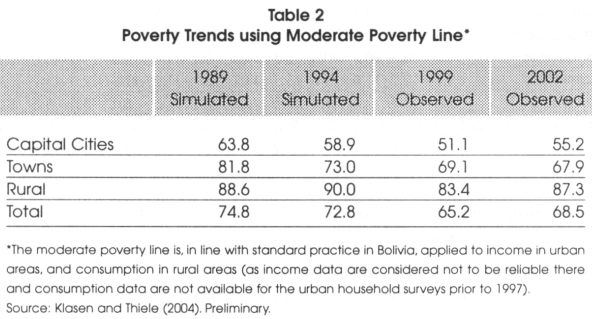
The second generation of reforms occurred over the period 1994 to 1997, focusing on transforming the role of the State in the economy from that of producer to regulator and modernizing governmental institutions and frameworks. Regarding state efforts to combat poverty, the governmental decentralization reform is expected to have the most profound impacts in the medium and long term through a system of tax income redistribution to municipalities.
In spite of nearly a decade of reforms and market liberalization, however, the composition of GDP growth has barely changed in the last 12 years (see Table 3). The continuing dependence on agricultural activities (including agriculture, animal husbandry and fish production) combined with non-renewable resource extraction leave the country highly vulnerable to adverse shocks, especially to fluctuations in international commodity prices.
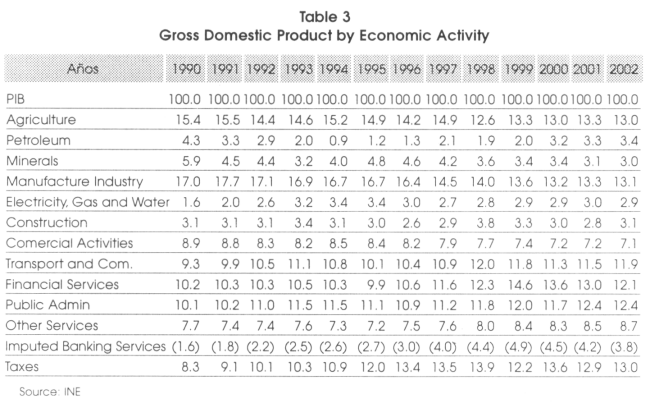
With the resignation of Gonzalo Sanchez de Lozada in October 2003, and former Vice President Carlos Mesa assuming the presidency, the role of traditional political parties in helping Congress work with the Executive Branch on legislation has changed dramatically. The current president is not a member of any political party and has staffed his cabinet with apolitical ministers. While there is a sense that the current government is reaching out to legitimate leaders of different social sectors to redirect public policy, it is perhaps too early to determine whether the inclusion of different voices and viewpoints in the design of macroeconomic policy can bring about greater social mobility and a significant reduction in poverty.
4. Recommendations on How to Increase Social Mobility and Long Run Growth
A variety of factors affect the level of social mobility in a country. The most important factor is perhaps the education system which determines the degree of equality of opportunity for young people. A free, high quality public education system would provide relatively equal education opportunities and thus supposedly high social mobility.
The education supply in itself is not enough to increase social mobility, however, as there are many other barriers to mobility. The first arises from differences in education demand between poor and rich families. Even if the direct costs of education were completely free, there will still be indirect costs (clothing, school supplies, transport, etc.) and opportunity costs (children cannot help as much with domestic and farm work) which tend to be relatively more important for poor families. Studying may also be more difficult and require more effort for poor children as their study environments are less ideal (lack of parental support, no computers and books at home, etc). Educational quality is another factor - incentives to place the best teachers in remote rural areas are expensive and often inadequate. Bolivia has yet to become as urbanized as many neighboring countries, and the geography and difficult access to rural areas is another factor which challenges the provision of quality educational access to all regions of the country.
A second type of barrier to social mobility are found in the labor market in the form of discrimination. Discrimination essentially reduces the returns to education for the groups of people who are discriminated against, making it less likely that these groups will make the necessary education investments. If jobs are allocated more on the basis of family, political, ethnic or social ties than on the basis of merit, this would have the same negative effect on social mobility and growth.
A third barrier is found in the credit market. If people do not have access to credit at reasonable terms, they cannot make the investments necessary to improve their lives in the future. Bolivia is considered a pioneer in the microcredit market along with Bangladesh, and this financial sector appears to have weathered the ongoing economic crisis better than the traditional banking sector. In a relevant study of the poverty alleviation effects of microcredit in Bolivia (Navajas, 2000), the authors find that microcredit in Bolivia appears to serve not the very poorest but rather those on the upper edge of the poverty line. In addition, microcredit apparently serves more to smooth consumption rather than to increase incomes. It is to be expected, given the resistance of this financial service sector to the economic downturn in the country, that microcredit will continue to expand throughout the country and consolidate market share in the near future. As consumption smoothing is important to ameliorate the opportunity costs of children attending school and thus reducing schooling gaps, access to microcredit may have important and measurable effects on social mobility in future generations.
A fourth barrier is related to the marriage market. If people marry almost exclusively within their own social class, such marriage customs would tend to reduce social mobility. On the other hand, if people marry across social and economic classes, this would have a positive effect on social mobility and at the same time reduce inequality.
It has also been shown that the degree of urbanization has an impact on social mobility, with highly urbanized countries enjoying more social mobility, and urban people typically being more socially mobile than rural people. This can be partly explained by the easier access to education in urban areas, but probably also by the wider range of work opportunities found in urban areas. Finally, high fertility rates, with the associated high dependency burdens, may also be an obstacle to social mobility.
Below, we will explore the importance of some of these factors in the case of Bolivia and use the results to develop an agenda of policies for improving social mobility.
4.1 The Education System
A free education system of high quality would seem the obvious way of improving social mobility. Theoretically, any child could then get the education he or she wanted, independently of his or her family background. However, the child's idea of the ideal education may still depend on family background, so social mobility would not necessarily be perfect.
The education system in Bolivia is very far from the target of being free and of uniformly high quality. Although close to 95 per cent of 7-13 year olds attend school, most of them benefit little from the education in terms of future earnings, and many do not even learn the basic skills they are required to learn.
Bolivian students, especially those in public schools, score very low on academic aptitude tests compared to students from other Latin American countries and the gap between public and private school students is among the highest in the region (see Figure 6). This is a serious impediment for social mobility, since the poor who cannot afford private education, end up with an education that is substantially inferior to that of their richer counterparts, and this disadvantage is likely to carry through their entire lives and through the lives of their children too.
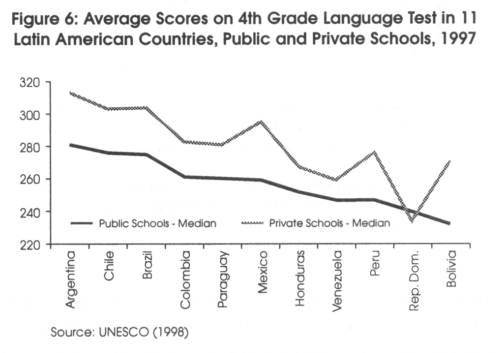
Bolivia has created a system of measurement of education quality (SIMECAL) to understand the magnitude and causes of the problems in the education system. Children are tested regularly and results compared with personal and school characteristics. Results indicate that an important reason for low and insufficient achievement is missing initial education or late school start.
The importance of early school start is supported by the findings in Andersen (2001a), which show that, across Latin American countries, the countries where children start school at age seven instead of age six (i.e. Guatemala, Brazil, Nicaragua, and Honduras), are among the countries with the largest schooling gaps and the lowest social mobility (see Figure 7). The correlation across Latin American countries between school start age and social mobility is -0.54, and the correlation between school starting age and teenage schooling gaps is 0.66, indicating that it is an advantage to send children to school at age six rather than seven.
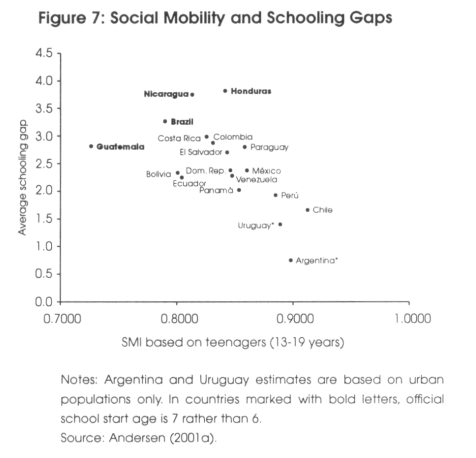
The results of SIMECAL suggest that it may be an advantage to send children to school even earlier than age six. Most rich families in Bolivia already send their children to pre-school around age three, implying that these children develop a firm habit of going to school, a habit of studying and learning, which will improve their grades and make it unlikely that they drop out of school prematurely. The children who have attended pre-school have a three or four year advantage over the poor children that are not allowed to enter the public education system until after their sixth birthday. In rural Bolivia, many children delay starting school until they are seven or eight (Urquiola 2000). This is too late an age to establish a solid habit of studying, and the probability that these late starters will drop out early is very high.
This suggests two necessary initiatives for Bolivian policy makers. First, they should offer pre-school facilities in public schools. Second, they should make sure that children do not start school too late.
4.2. Discrimination
Discrimination may be defined as unfair treatment of one person over another based on factors unrelated to their productivity. In Bolivia, there are many factors that are used to discriminate. Women, for example, typically earn about 25 per cent less than men even if they have the same level of education and occupy similar positions. (Mercado, Andersen and Muriel, 2003). Such gender based discrimination may be partly explained by the higher probability of shorter or more prolonged absences among women due to child bearing and rearing, but it would still tend to reduce the incentives for women to invest in education.
Ethnicity is also a common ground for discrimination. Although a recent study by Mercado, Andersen and Muriel (2003) show that most of the wage discrimination against indigenous people can be explained by their lower quality of education, this will still reduce the incentives to invest in education for any individual indigenous person, as education quality is difficult to observe, and employers tend to just assume that indigenous people have attended low quality public schools in rural areas. A person would have to really stand out in order to overcome that basic assumption.
In the public sector, which accounts for the gross share of total salary income in Bolivia, there is another discrimination factor that is extremely important -namely political affiliation. Jobs at all levels ranging from ministers to chauffeurs, especially in the government, are allocated based on party affiliation or family connections. Even teaching posts, which are clearly not the most attractive public sector positions, are distributed more on the basis of political affiliations than professional qualifications. In positions with more power (especially to extract rents) this unfortunate situation is even more pronounced, with 75 per cent of all positions in the Internal Revenue Service being allocated on political grounds. The same holds for the Customs Agency. Outright purchasing of attractive public positions is also quite common (Kaufman, Mastruzzi and Zavaleta, 2003).
When public sector jobs are allocated more on the basis of gender, ethnicity, political affiliation, family connections or capacity to pay bribes than on merits and productivity, this not only dramatically reduces productivity, but also obstructs social mobility. Girls born in rural areas to poor, indigenous parents will face severe constraints in the labor market no matter how talented and well-educated they might be. With such a massive handicap, it is no wonder if her parents find that investment in her education is likely to be a bad investment, and her fate is essentially determined from birth.
4.3. The Marriage Market
The marriage market can work either to increase or to decrease social mobility, depending on the degree of cross social sector marriages in the country. If people tend to marry only people from their own class, then social mobility is restrained by marriage customs. If, on the other hand, people often marry outside their class, then social mobility is promoted by the marriage market. In addition, inequality will be lower, since resources are spread out more evenly across households.
A simple measure of the degree of cross social sector marriages is the correlation between spouses' education levels, ρm. This correlation is generally high in Latin America -ranging from 0.67 in Costa Rica to 0.79 in Bolivia. The corresponding figure for the United States in 1990 is 0.62 (Kremer, 1996). The higher the correlation, the lower the contribution to social mobility.
In Bolivia, the marriage market contributes to low social mobility as the correlation between spouses' education levels is extremely high (see Figure 8).
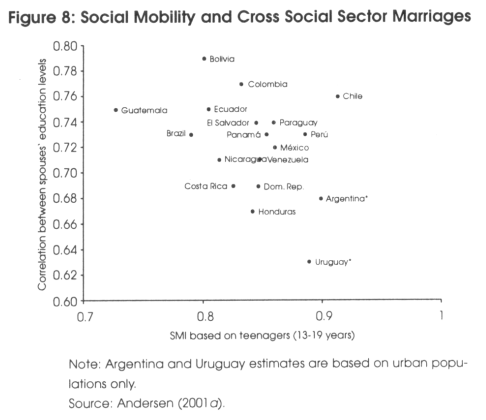
While a low degree of cross social sector marriages has a negative impact on equality and lowers social mobility, the situation also has a positive side. Becker (1991) argues that parents have a greater incentive to invest in their childrens' education if this increases the child's chance of marrying a desirable spouse. Kremer (1996) finds that an increase in rm from 0.6 to 0.8 will increase the returns to investment in education by 12.5 percent. In effect, imperfectly assortative marriage can be seen as a tax on parents' investment in their children, with the proceeds going to the children-in-law (Kremer, 1996).
The segmentation of marriage markets is also highly evident in the ethnic dimension. Table 4 shows that only 8 per cent of all couples are mixed indigenous/non-indigenous while the remaining 92 per cent find partners within their own ethnic group. In the group of mixed couples, the indigenous person tend to be better educated, and relatively well-off compared to the indigenous persons in non-mixed marriages, whereas the non-indigenous persons tend to have less education and less income than their non-indigenous counterparts in non-mixed marriages. This is an indication that in the few cases were we do observe ethnic mixing, it is only at the border - the "most attractive" indigenous persons marrying the "least attractive" non-indigenous persons.
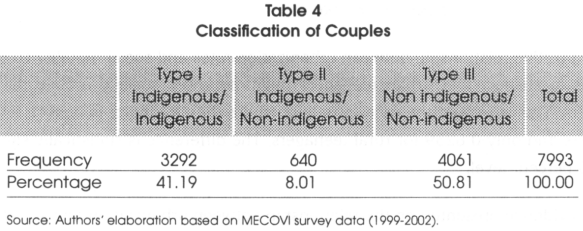
While it is clear that the marriage customs in Bolivia contribute to low social mobility, public policy cannot do much to change this situation.
4.4. Urbanization
There is a tendency for highly urbanized countries to have higher social mobility than less urbanized countries, probably because it is easier for the governments to provide better quality education to everyone if the children are clustered together in urban centers. Figure 9 shows the relationship between urbanization rates and social mobility, with Argentina and Uruguay having 100 per cent urbanization rates as the samples are solely from urban populations.
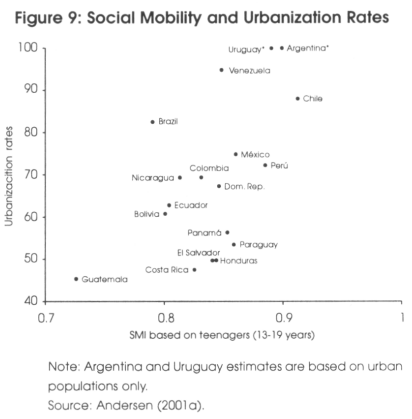
The positive relationship between urbanization rates and social mobility (ρ = 0.55) leads us to suspect that urban teenagers might be more socially mobile than rural teenagers. This is indeed the case in Bolivia where the SMI index is 0.8841 for urban teenagers and only 0.8239 for rural teenagers. The difference is statistically significant at the 5 percent level.
The evidence presented on the relationship between urbanization and social mobility suggests one additional reason for encouraging rural-urban migration in Bolivia. It is much cheaper for the government to provide good quality schooling when students are gathered in urban centers to take advantage of economies of scale.
4.5 Corruption
Corruption has important effects on social mobility, especially when it implies that jobs are not allocated based on productivity considerations but rather on political or family ties. In such a labor market, the persons whose families are not well connected will have less access to certain jobs regardless of their qualifications, and their social mobility is thus reduced.
It is difficult to measure these job-matching imperfections, but Figure 10 shows that the more general Corruption Perception Index from Transparency International also is highly correlated with our Social Mobility Index. Notice that the scale is inverted so that higher CPI scores imply less corruption.
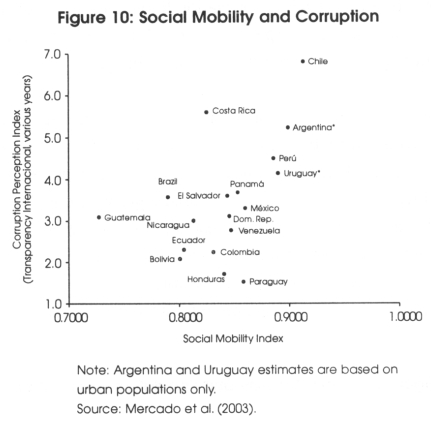
A more detailed survey concerning different kinds of corruption in different institutions, show that there is large variation in corruption across institutions in Bolivia. The Central Bank, the Ombudsman and the Constitutional Tribune, for example, score high on transparency and service delivery performance and low on bribery and politicization. The police force in Santa Cruz, on the other hand, scores very low on transparency and service delivery performance, and very high on bribery. The Customs Department, Tax Department, and High Court in Santa Cruz are also reported with high levels of bribery and low performance, while the corresponding institutions in other regions are doing somewhat better. Some of the highest levels of politicization are found in La Paz, in the Municipal Government, in the Prefecture, and in the National Customs.
Service delivery performance does not at all seem to be related to wage satisfaction within the institutions. The public officials in the Central Bank score very low on wage satisfaction, while those in the Tax Department and High Court of Santa Cruz score quite high.
4.6 Population growth
Figure 11 shows that the negative correlation between population growth rates and social mobility is relatively strong (ρ = -0.54) and Bolivia is located in the "bad" end with high population growth rates and low social mobility.
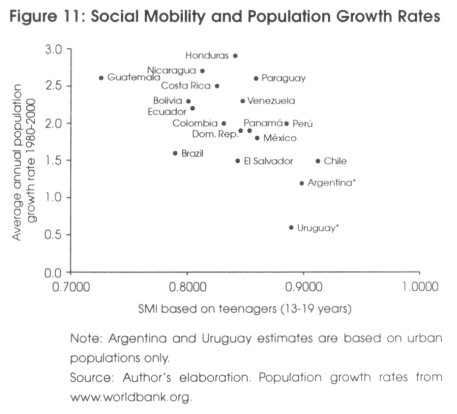
The strong correlation does not imply anything about causality, but it seems logical that high fertility rates, with the associated high dependency burdens, may be an obstacle to social mobility. At the macro-level, countries with high fertility rates will have difficulties in supplying basic services to the rapidly growing population, and the ones left without services are likely to be the poorest and most marginalized groups. For poor families, many children will likely to imply less investment in each child due to a tight budget constraint, whereas this is not necessarily the case for richer families. This implies that high fertility is more of a problem for poor families and thus tends to reduce social mobility.
4.7 How to Increase Social Mobility in Bolivia
After revising both the theoretical and empirical literature on social mobility and investigating social mobility in Bolivia in particular, a number of policy recommendations can be extracted. We have divided them below under two main headings: education and corruption.
Education
The education system is fundamental for achieving greater social mobility, and although the improvement of the public education system has been high on the agenda in Bolivia for at least a decade, the recommendations arising from the present analysis differ in important aspects.
Traditionally, the main purpose of public investment in education has been to increase the general level of education in the country. For us, however, the main purpose is to create equality of opportunity and thus increase social mobility. The distinction is important because general increases in education levels will not necessarily have a positive effect on average productivity and earnings. While investment in education is clearly important for earnings at the individual level, this is not necessarily the case at the macro level. A famous World Bank study even found a significantly negative effect of public education spending on economic growth (Pritchett, 1996) and listed the following three arguments to explain how this can be possible.
First, education may work purely as a signalling device, in which case you would find a positive benefit of education at the individual level, not because education has improved the individual's productivity, but because education is a signal for innate talents. In this case, education will have no impact on growth at the macro-level, because it has not contributed to an increase in productivity. Indeed it may even decrease productivity as people are spending several years on unproductive studies rather than working.
Second, marginal returns to education fall rapidly if demand for education is stagnant. In a very static society where the skill demand of employers do not change much over time, an increase in the general level of education may not translate into higher wages. It is quite possible that all jobs are occupied by the same people, with the same productivity, but all with two more years of education. In such a situation, higher education will not translate into higher incomes and higher growth Even though well-educated people earn higher salaries now than lesser educated people, this in no way implies that if everyone had more education, everyone would be earning higher salaries. Quite the contrary, a rapid increase in education levels might result in more educated people being unemployed, because demand is not increasing as fast as supply.
Third, there may be perverse incentives causing people to educate themselves for counter-productive activities (bloated bureaucracy, rent-seeking activities, etc.). In this case education will prove to be beneficial at the private level, but not at the national level, as educated people would tend to engage in anti-social activities (e.g., corruption).
This suggests that the aim of the public education system should not be just to give more education universally, but rather to ensure that all children receive an education that corresponds to and reinforces their innate talents and interests, thus providing that they can be as productive as possible in the future.
Since talents, interests and learning styles differ greatly from child to child, this requires a very flexible education system. The objective of the education system should be to help each child identify their talents and help them develop those talents, rather than just putting each and every child through the same standardized 12-year curriculum. It is important to develop the uniqueness in each person, as this is what pays in the labor market. Those who have unusual skills demand much higher salaries than those who have the most common combination of skills.
Thus, we do not necessarily need more education, and we certainly do not need equality in education. What we need is that all people have access to individualized education that corresponds to their innate abilities and interests, so that they can become as productive as possible in their future work lives. This requires a completely different approach than the typical universal primary education strategy.
The longer that people remain in the education system, the greater the possibilities to differentiate. However, the traditional focus on universal primary education means that the labor market receives a large number of people with average and very similar qualifications, which is going to help neither the employers nor the employees much.
An individualized education system can take many forms, but it will always involve more options for the students. For example, children (together with their parents) should be able to choose which languages they want to learn and at which age, and they should be able to choose between abstract and more practical courses. For topics that are considered essential for all (such as math) they should be able to choose between basic and advanced levels, so that the students who choose the advanced level learn the topic in more depth as necessary for continued studies or work with heavy focus on that area, while children choosing the basic level learn sufficient material for everyday life.
A more flexible learning environment is likely to reduce both drop-out rates and repetition rates, as children spend more time on the topics they enjoy and less time on topics they dislike. This will not only save money, but it will also save the children from experiences that can be very damaging for their self-esteem, and thus for their future income earning capacity. It is also important that children get introduced to the education system at an early age, to take advantage of their natural curiosity and desire to learn and to establish good studying habits.
More options for the students obviously mean more complications for the teachers and administrators. In small, rural schools where one or two teachers are responsible for all the classes, it will obviously be difficult to supply several different foreign languages and all imaginable topics at high level. However, these small schools have the advantage of teachers knowing each child better and thus better able to adjust to individual needs. In addition, the technological advances in the areas of telecommunication, computation, and virtual education are rapidly making flexibilization easier and cheaper.
A better education system yielding higher returns to education is likely to have the additional benefit of reduced fertility, which was shown to be associated with higher social mobility. Fertility can of course also be affected directly by providing better access to and information about effective family planning methods.
Corruption and Rent-Seeking
The possibility of corruption and other privately profitable but socially damaging activities seriously reduce the possible benefits of higher social mobility. Equality of opportunity is no advantage if everyone wants to engage in rent seeking activities instead of productive activities that help generate sustainable growth in the long run.
Due to the weakness of the private sector to generate gainful employment in Bolivia, public sector jobs are very attractive, and politicians use these sought-after jobs to buy favors, return favors and secure political support, largely disregarding considerations concerning qualifications and productivity. This not only hurts overall productivity, but also social mobility. People's effort and qualifications should determine their job possibilities, not their family background and political connections.
The malfunctioning of large parts of the public service sector due to politicization and clientilism is widely acknowledged and large and expensive efforts have been launched to improve the situation. In 1992, a civil service reform program was initiated to create a corps of technically competent and motivated public employees that would not be forced out with every change of ministers. The aim was to create a critical mass of around 2,500 employees, yet by 1997, less than 250 positions had been included in this categorization, and this number decreased to only 30 by 1998 due to extremely low retention rates, so the program lost credibility and stopped (Kaufman, Mastruzzi and Zavaleta, 2003).
Institutional strengthening remains one of the top priorities for the international development community in Bolivia. Between 1998 and 2002, the international cooperation partners spent more than $400 million on this topic, corresponding to 15 per cent of total outlays more than they devoted to education and health together. Despite the great emphasis and large amount of funds devoted to institutional strengthening, results have been very disappointing. Since the launch of the new program of institutional reform (PFU) in the year 2000, only about 2,000 public positions have been institutionalized, compared to the 42,4174 public positions listed in the national public servants registry. It is also discouraging to note that only 26.5 per cent of public servants declare that they have entered the institution in a public competitive process (Andersen and Evia, 2003).
It is not only illegal activities, such as corruption and direct robbery, which distort the incentives and obstructs the correct functioning of the economy. Many legal activities also skew incentives against sustainable productive activities. One example is foreign aid, which contributes close to 10 per cent of Bolivia's GDP through thousands of short and medium term projects. Many of these projects have no permanent impact, and attract human and financial resources away from other, possibly more sustainable and productive, activities (see Andersen and Evia, 2003). Another example is the abundance of natural resources, which tempts the country to rely on the exploitation of non-renewable resources instead of producing goods and services in a sustainable manner.
The small size of the domestic market coupled with the country's lack of sovereign coastal access are two exogenous factors limiting growth of the productive sector. The task of implementing the political and institutional changes that are needed to eliminate misgovernance and reduce rent-seeking behaviour is daunting since most of these changes would go against the interests of the majority of insiders. Nevertheless, it is essential to improve the functioning of the economy. Productive activities in the private sector have to become relatively more attractive than rent-seeking activities in the public sector, and at the same time it would be desirable to make the formal sector relatively more attractive than the informal sector. This implies a range of initiatives ranging from the reduction of public sector salaries (already in progress) to the provision of public services for the private productive sector (typically infrastructure and technical education).
5. Conclusions
This paper has shown that despite decades of concerted national and international efforts to reduce poverty, Bolivia still has some of the highest poverty rates in Latin America, with virtually no improvement in the very poor rural areas. Although Bolivia has meticulously followed the recommendations of the Washington consensus at the same time as external aid has been generous and foreign direct investment has boomed, average productivity and incomes remain at the same low level as they were both 20 and 50 years ago.
The paper argues that the failure of previous development policies is due to a lack of social mobility in the country. Without social mobility, there is little incentive for people to invest in human and physical capital, and without investment there cannot be productivity growth. In addition, the lack of social mobility implies an inefficient use of human capital, and it hinders the construction of efficient social mechanisms of redistribution and consumption smoothing over the life-cycle.
Efforts to improve social mobility in Bolivia should concentrate on the public education system and the elimination of corruption and misgovernance. Social mobility may also be increased through improvements in the functioning of credit markets and through improved family planning services.
While we do not necessarily need more education or more equality in education, we do need a better and more flexible education system that is capable of supplying an individualized education appropriate to the talents and interests of each child, independently of family background. The education system should help each child identify their unique talents and secure them the possibility of developing those talents, so that each person can become as productive as possible during their future work life. In this way the human capital in the society can be used more optimally, thus permitting higher growth rates.
While high growth requires high social mobility, this is not a sufficient condition. It is also required that productive activities yield higher returns to talent than to unproductive rent seeking activities. If talent is attracted to rent seeking activities rather than productive activities, then no amount of social mobility can generate growth. It is therefore a very high priority that corruption be reduced so that productive activities become attractive.
Future Research
There are two main directions in which the work on social mobility could be extended and improved. The first is to add a time dimension to the social mobility index in order to test the hypothesis that social mobility has improved in Bolivia during the last couple of decades. Having several observations of the social mobility index over time would also help establish the level of confidence we should have in this measure. If it varies wildly from year to year, it is clearly not a very useful measure, whereas it would be interesting to determine whether there is a clear trend over time. A time series would also permit testing the causality hypotheses presented in this paper, to determine the direction of influence between related events.
The second direction of improvement would be to take into account differences in education quality in order to reduce the systematic biases that the omission of this causes in the estimated social mobility index. The simplest way to do this would be to include a dummy for public/private education in the schooling gap regressions, but unfortunately such information is not always available. More elaborate techniques to estimate school quality for young people in Bolivia have been proposed by Andersen and Muriel (2002) and applied in Mercado, Andersen and Muriel (2003).
It is also clear that much more research is needed on effective ways to reduce corruption and public mismanagement in Bolivia. There have been some successes and many failures, and lessons should be learned from these.
Notas
* This paper was prepared for The North-South Institute ¡n the context of the Institute's project: "Macroeconomic Policy Choices for Growth and Poverty Reduction." The very constructive comments received from Rodney Schmidt, Clive W. J. Granger and Bent Jesper Christensen are highly apreciated, as ¡s the help we received from our research assistant, Luis F. Lima Soria.
** A. F. Mercado: Director-IISEC; L. Andersen: UNDP-BOL; A. Brooks: Associate Researcher-IISEC.
1 Transparency International, a global coalition against corruption, monitors corruption perceptions around the world. According to their most recent figures (2003). Bolivia is 106th out of 133 countries investigated (www.transparency.org) ranked with lesser corrupt nations at the top of the list. This is a relative improvement over the country's assessment in 1997, where Bolivia was found to be the second most corrupt country in the world.
2 This was measured prior to the Argentinian economic collapse - the GDP per capita figures were inflated by the artificial exchange rate.
3 A Survey of Public Officials (more than 1200 public officials working on over 100 different institutions) carried out by the World Bank. Results reported in Kaufmann, Mehrez and Gurgur (2001)
4 This figure comprises the central administration, decentralized institutions of departmental administrations, municipal governments, judiciary power, legislative power, electoral court, and the administrative staff of the health and education sector. It does not include the rural and public teachers, administrative staff and professors of public universities, police, army, and the foreign service.
REFERENCES
Andersen, Lykke E. 2001a. "Social Mobility in Latin America: Links with Adolescent Schooling". Inter-American Development Bank, Research Network Working Paper No. R-433.
Andersen, Lykke E. 20015. "Low Social Mobility in Bolivia: Causes and Consequences for Development". Institute for Socio-Economic Research, Universidad Católica Boliviana. Working Paper No. 3/2001, May.
Andersen, Lykke E. and Jose L. Evia. 2003. "The Effectiveness of Foreign Aid in Bolivia". Institute for Socio-Economic Research, Universidad Católica Boliviana. Working Paper No. 10/2003, December.
Andersen, Lykke E. and Beatriz Muriel, 2002. "Cantidad versus calidad en educación: implicaciones para la pobreza". Revista de Estudios Económicos y Sociales, Vol. 1, pp. 9-41.
Baumol, William j.,. 1990. "Entrepreneurship: Productive, Unproductive and Destructive". Journal of Political Economy, Vol. 98(5), pp. 893-921.
Becker, Gary S. 1991. A Treatise on the Family. Enlarged Edition. Cambridge, Mass.: Harvard University Press.
Behrman, Jere R., Nancy Birdsall and Miguel Szekely. 1998. "Intergenerational Schooling Mobility and Macro Conditions and Schooling Policies in Latin America". Inter-American Development Bank, Office of the Chief Economist. Mimeo.
CEDLA. 2003. "Servicio de crecimiento y reducción de la pobreza: un callejon sin salida". La Paz.
Dahan, Momi and Alejandro Gaviria. 2000. "Sibling Correlations and Social Mobility in Latin America". Inter-American Development Bank, Office of the Chief Economist. Draft, March.
Fields, Gary S. 1996. "Accounting for Differences in Income Inequality". Draft, School of Industrial and Labor Relations, Cornell University, January.
Galor, Oded and Daniel Tsiddon. 1997. "Technological Progress, Mobility, and Economic Growth". American Economic Review 87(3), 363-382.
Hassler, John and Jose V. Rodriguez Mora. 2000. "Intelligence, Social Mobility and Growth". American Economic Review 90(4), 888-908.
Hassler, John, Jose V. Rodriguez Mora and Joseph Zeira. 2002. "Inequality and Mobility". Institute for International Economic Studies, Stockholm University. January.
Kaufmann Daniel, Maximo Mastruzzi and Diego Zavaleta. 2003. Chapter 12 in In Search of Prosperity: Analytic Narratives on Economic Growth. Ed. D. Rodrik, Princeton University Press.
Kaufmann D, G. Mehrez and T. Gurgur 2001. "Voice or Public Sector Management?: A Model and Analysis based on a Survey of Public Officials", The World Bank.
Kremer, Michael. 1996. "How much does sorting increase inequality?" NBER Working Paper No. 5566. May.
Mercado, Alejandro F., Lykke E. Andersen, Osvaldo Nina and Mauricio Medinaceli, 2003. "Modelo alternativo de desarrollo: una agenda de políticas para la nueva decada". Final Report. IISEC/PIEB. December.
Mercado, Alejandro F, Lykke E. Andersen and Beatriz Muriel. 2003. "Discriminación étnica en el sistema educativo y el mercado de trabajo de Bolivia". Latin American Journal of Economic Development, Vol. 1, pp. 11-36.
Morales, Juan Antonio. 1995. "Los problemas postestabilización en Bolivia". En: Inflación, estabilidad y crecimiento. Institute for Socio-Economic Research, Universidad Católica Boliviana.
Morales, Juan Antonio and Jeffrey Sachs. 1990. "Bolivia's Economic Crisis". In: Sachs, Jeffrey (ed.) Developing Country Dept and Economic Performance. Vol. 2. Chicago: University of Chicago Press.
Murphy, Kevin M., Andrei Schleifer and Robert W. Vishny. 1991. "The Allocation of Talent: Implications for Growth". Quarterly Journal of Economics, Vol 106(2): 503-530.
Navajas, Sergio. 2000 "Microcredit and the poorest of the poor: Theory and evidence from Bolivia". Preliminary version of the published in World Development. Vol. 28, No, 2, pp 233-346
Nina, Osvaldo and Dirk Willem te Velde. 2003. "Foreign Direct Investment and Development: The Case of Bolivia". Carta Informativa No. 1, Grupo Integral, La Paz, Mayo.
Pritchett, Lant. 1996. "Where has all the education gone?" Policy Research Washington, DC: The World Bank, March. Working Paper No. 1581.
Raut, Lakshmi K. 1996. "Signalling equilibrium, Intergenerational mobility and long-run growth". University of Hawaii-Manoa. Draft. February.
Szekely, Miguel and Marianne Hilgert. 1999. "What's Behind the Inequality We Measure: An Investigation Using Latin American Data for the 1990s". Research Department at the Inter-American Development Bank. Draft, December 3.
Transparency International. 2003. The 2003 Corruption Perception Index.
UNESCO. 1998. Primer estudio international comparativo sobre lenguaje, matemática y Factores Asociados en Tercero y Cuarto Grado. Santiago, Chile.
Urquiola, Miguel. 2000. "Educación primaria universal". In: UNDP (2000). Remontando la pobreza: ocho cimas a la vez. La Paz: EDOBOL.














